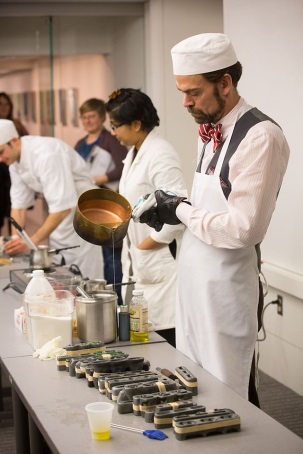From mouth-puckering sour gummies, to milky chocolate cups with peanut butter or fruity centers, candy is tasty as it is unique – and it turns out chemistry plays a large part in what makes Halloween trick or treating so “spooktacular” and so sweet.
So, here’s an “inside look” at candy chemistry and the manufacturers that produce consistently delicious treats day after day (and just like anything that’s delicious, treats that should be consumed in moderation!).
How sugar is made
What we call sugar, the chemist knows as ‘sucrose.’ First, sugar cane and other plants that make sucrose must be harvested. Near infrared spectroscopy (NIRS) and sensors, which often depend on benefits of rare earth technology, are both used to check plant quality.
There are a lot of variations made by manufacturers for actually processing, but generally raw sugar manufacturing goes through the following steps: extraction of the cane juice by milling or diffusion, clarification of the juice, concentration of the juice to syrup by evaporation, crystallization of sugar from the syrup, and separation and drying of the crystals.
Candy mixing
Raw materials including sugar and/or other separate ingredients are poured into big mixing tanks. This act, called compounding, is usually the first step in candy manufacturing.
These tanks or vats are sophisticated machinery—equipped with mixing, heating, and cooling capabilities. The vats are often insulated and can be designed of aluminum insulated with polyurethane. Tanks and vats are one of the first pieces of machinery equipment used in many candy manufacturing processes and the chemistry provided by the polyurethane used to insulate the equipment keeps candy heated consistently.
Candy molding
Once candy ingredients are mixed, candy molding equipment can give a confection a unique design or detail. Molding techniques often include polycarbonate injection molds and rubber molds.

Hot liquid candy being poured into candy molds by a candy maker. Creative Commons Image courtesy of Chemical Heritage Foundation.
Clear and durable polycarbonate plastic allows candy makers to see when the chocolate has set and pulled away from the mold, while chemistry that makes molds flexible gives candies fun shapes like hearts or ghosts.
Candy Cooling
Candy manufacturers use refrigerant machines to cool air in rooms for candy cooling and conveyer belts that can blow air on sweets. Rapid cooling effects from machines can give candies such as chocolate a glossy appearance.
Liquid nitrogen can be used for flash freezing. Frozen dioxide, or dry ice, can be used to keep candy cool during shipping or for making other cold treats.
Candy Wrapping
Packaging preserves candy aroma, flavor and keeps our treats hygienic. Packaging makes shipping and dispensation more efficient.
As for the chemistry that goes behind candy wrapping, a class of chemicals called olefins can be manufactured to create polyethylene, a film that can be sealed with heat. It also allows for plastic films with mechanical properties that can be twisted into wraps around candies such as peppermints.
Quality control
Finally, candy quality is checked with high speed check weighers, metal detectors and x-ray systems which incorporate innovations in nanotechnology and rare earth elements. But consumers get the final taste test!
3D printing
Could the candy manufacturing process get easier with 3D printing? We asked the question during the American Chemical Society’s recent webinar “Sweet Science: Having Fun with Candy Chemistry,” featuring Dr. Rich Hartel, a professor of food engineering, from University of Wisconsin-Madison and Dr. Matt Hartings, a chemistry professor from American University.
Dr. Rich Hartel answered that he had “skepticism” that 3D printing could get “structures we want in foods” but it was something he had been recently wondering about. Other webinar topics include the chemistry of taste and chemical reactions that occur when making sweet confections — so be sure to check it out!
More information
Want to learn more about how chemistry keeps food maintained at a high quality that is both fresh and safe? Visit ACC’s Consumer Safety Page.






